HI6008 Business Research: Promoting Religious Diversity in Workplace
VerifiedAdded on 2023/03/30
|19
|4712
|397
Report
AI Summary
This business research report investigates religious diversity in Australian workplaces, addressing the research question of how to avoid religious discrimination and promote inclusivity. The report summarizes a literature review that defines workplace diversity, highlights its benefits, and identifies challenges to religious diversity, such as religious intolerance and inadequate legal protections. Findings from the 2016 census reveal the religious and ancestral diversity of Australia, particularly in Greater Melbourne, while also noting instances of discrimination against minority religious communities like Sikhs and Muslims. The research employs a qualitative analysis methodology, drawing upon peer-reviewed academic journals to identify common themes and propose strategies for fostering religious tolerance and equal representation in the workplace and educational institutions. The report also touches upon the challenges faced by religious schools in Australia and how they can be more inclusive.

name of student
name of college
authors note
BUSINESS RESEARCH
1
name of college
authors note
BUSINESS RESEARCH
1
Paraphrase This Document
Need a fresh take? Get an instant paraphrase of this document with our AI Paraphraser

BUSINESS RESEARCH
Contents
Introduction......................................................................................................................................3
The Literature Review.....................................................................................................................3
Research Methodology....................................................................................................................5
Summary of findings.......................................................................................................................5
References......................................................................................................................................14
2
Contents
Introduction......................................................................................................................................3
The Literature Review.....................................................................................................................3
Research Methodology....................................................................................................................5
Summary of findings.......................................................................................................................5
References......................................................................................................................................14
2
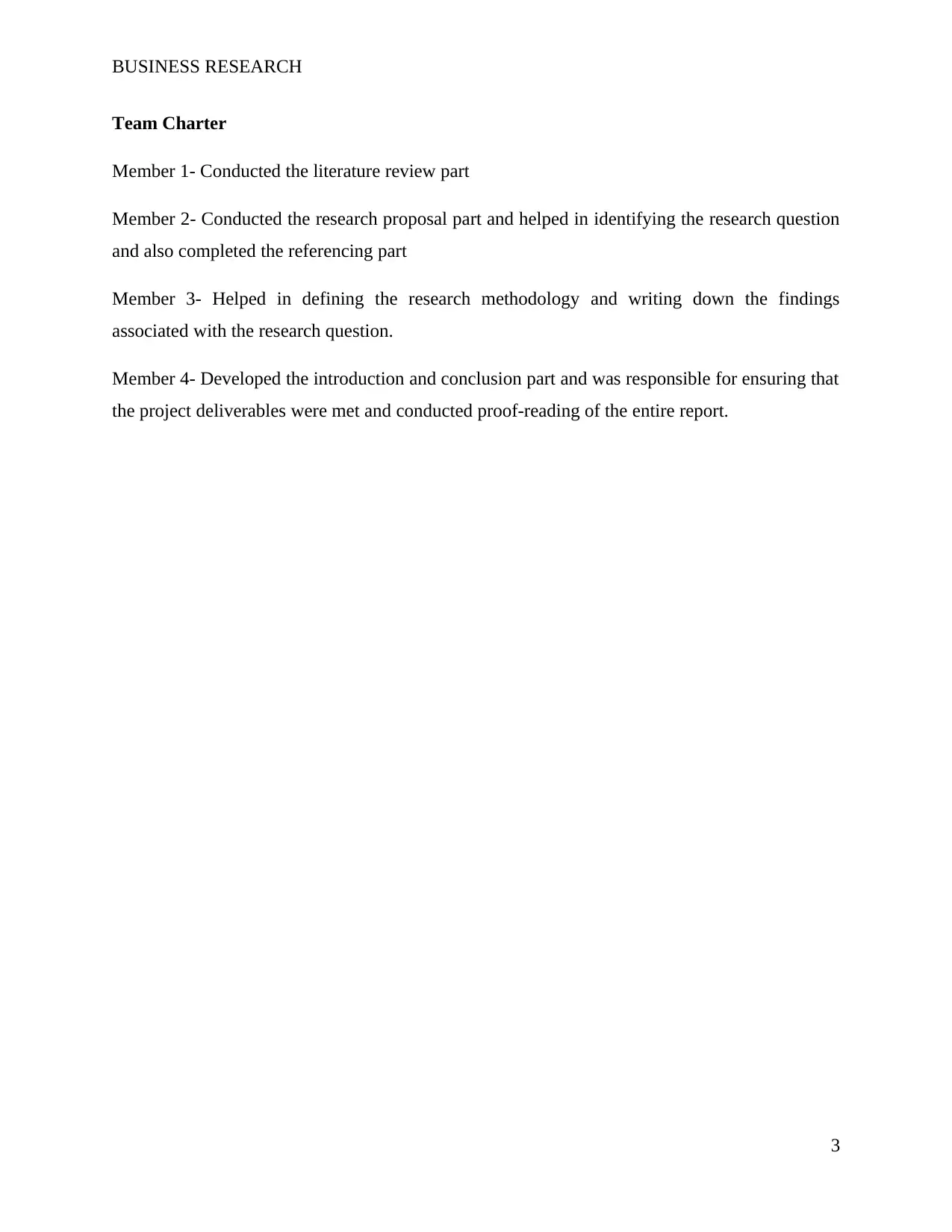
BUSINESS RESEARCH
Team Charter
Member 1- Conducted the literature review part
Member 2- Conducted the research proposal part and helped in identifying the research question
and also completed the referencing part
Member 3- Helped in defining the research methodology and writing down the findings
associated with the research question.
Member 4- Developed the introduction and conclusion part and was responsible for ensuring that
the project deliverables were met and conducted proof-reading of the entire report.
3
Team Charter
Member 1- Conducted the literature review part
Member 2- Conducted the research proposal part and helped in identifying the research question
and also completed the referencing part
Member 3- Helped in defining the research methodology and writing down the findings
associated with the research question.
Member 4- Developed the introduction and conclusion part and was responsible for ensuring that
the project deliverables were met and conducted proof-reading of the entire report.
3
⊘ This is a preview!⊘
Do you want full access?
Subscribe today to unlock all pages.

Trusted by 1+ million students worldwide

BUSINESS RESEARCH
Introduction
The previous research focused on conducting a literature review regarding research proposal of
workplace diversity, the various associated concepts of workplace diversity such as cultural
diversity, religious diversity etc. The literature review conducted in the previous assignment also
focussed on identifying the various factors which affects the attainment of religious diversity in
the workplace. The literature review which was conducted in the previous assignment also
focussed on highlighting the benefits which are offered by practicing religious diversity in the
workplace and also highlighted the challenges which are faced by business organizations
regarding attainment of religious diversity in the workplace. The research problem which was
identified in the previous assignment was that it did not help in highlighting the reason of
discrimination which is shown towards various other religious groups in Australian workplaces
and the recommendation to solve the issue. The research question for the current project is
“What steps needs to be taken in order to avoid religious discrimination in workplaces and the
society in order to promote religious diversity in workplaces?”The report will proceed by
summarising literature review which was conducted during the course of the previous
assignment. Also, current article will define the research methodology which has been selected
for the study. After defining the research methodology, the report will provide insights regarding
the findings which were associated with the research and which will help in addressing the
research problem identified in the previous research. Finally the report will end by providing a
conclusion of the research problem and the findings which have been made during the course of
the research.
The Literature Review
The concept of workplace diversity is defined as the process by which business organizations
aim to manage the diversity in their workforce in terms of gender, culture, ethnicity, race, age,
orientation, religion and citizenship. It is significant for enterprises to manage diversity in their
organization as the workforce of organizations which were once uniform in nature and have
become diverse in nature as a result of accumulation of various individuals in the organization
who have different religious and ethnic identity. (Das, 2014) In order to manage diversity ion the
workforce it is being observed that business organizations have adopted various diversity
management processes in the form of gender diversity management, culture diversity
4
Introduction
The previous research focused on conducting a literature review regarding research proposal of
workplace diversity, the various associated concepts of workplace diversity such as cultural
diversity, religious diversity etc. The literature review conducted in the previous assignment also
focussed on identifying the various factors which affects the attainment of religious diversity in
the workplace. The literature review which was conducted in the previous assignment also
focussed on highlighting the benefits which are offered by practicing religious diversity in the
workplace and also highlighted the challenges which are faced by business organizations
regarding attainment of religious diversity in the workplace. The research problem which was
identified in the previous assignment was that it did not help in highlighting the reason of
discrimination which is shown towards various other religious groups in Australian workplaces
and the recommendation to solve the issue. The research question for the current project is
“What steps needs to be taken in order to avoid religious discrimination in workplaces and the
society in order to promote religious diversity in workplaces?”The report will proceed by
summarising literature review which was conducted during the course of the previous
assignment. Also, current article will define the research methodology which has been selected
for the study. After defining the research methodology, the report will provide insights regarding
the findings which were associated with the research and which will help in addressing the
research problem identified in the previous research. Finally the report will end by providing a
conclusion of the research problem and the findings which have been made during the course of
the research.
The Literature Review
The concept of workplace diversity is defined as the process by which business organizations
aim to manage the diversity in their workforce in terms of gender, culture, ethnicity, race, age,
orientation, religion and citizenship. It is significant for enterprises to manage diversity in their
organization as the workforce of organizations which were once uniform in nature and have
become diverse in nature as a result of accumulation of various individuals in the organization
who have different religious and ethnic identity. (Das, 2014) In order to manage diversity ion the
workforce it is being observed that business organizations have adopted various diversity
management processes in the form of gender diversity management, culture diversity
4
Paraphrase This Document
Need a fresh take? Get an instant paraphrase of this document with our AI Paraphraser
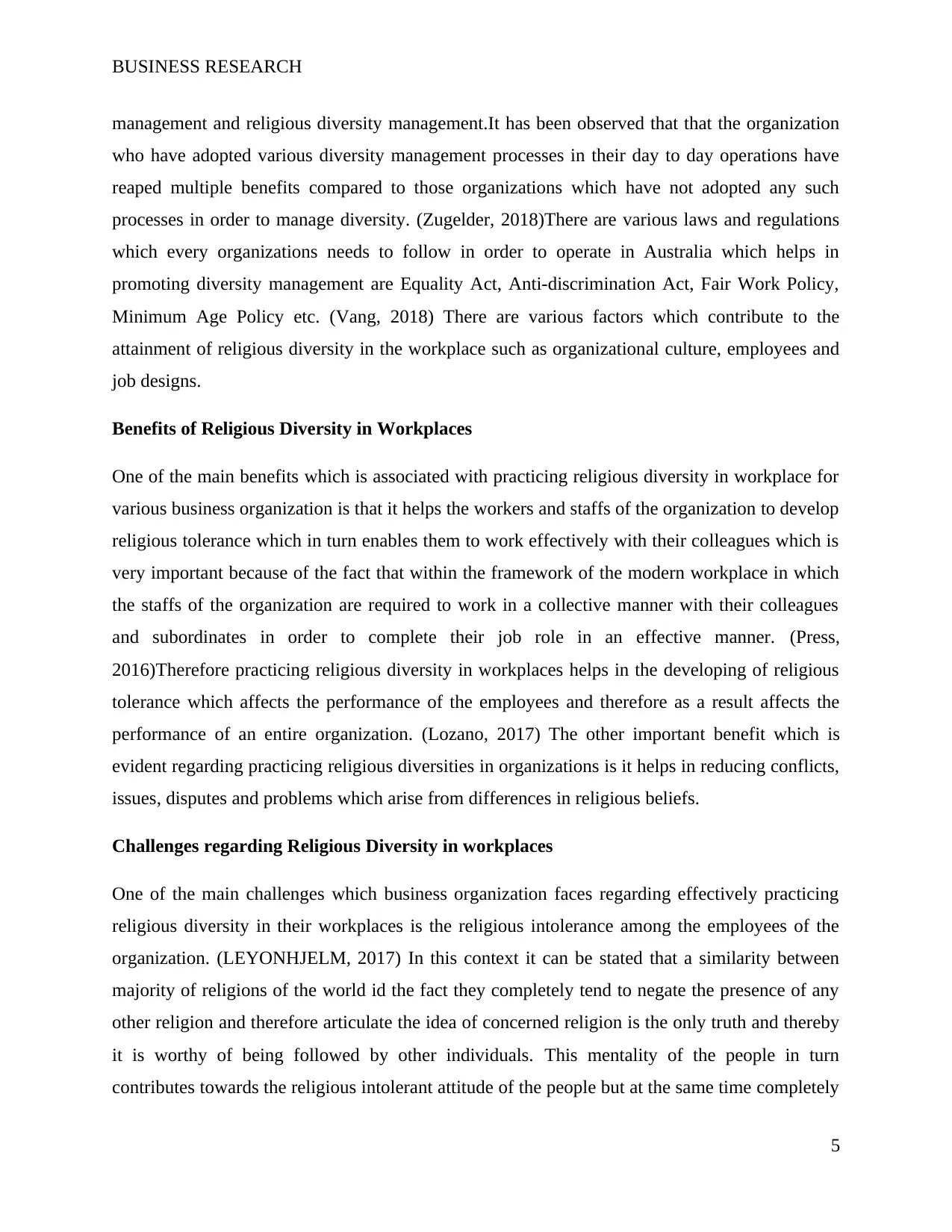
BUSINESS RESEARCH
management and religious diversity management.It has been observed that that the organization
who have adopted various diversity management processes in their day to day operations have
reaped multiple benefits compared to those organizations which have not adopted any such
processes in order to manage diversity. (Zugelder, 2018)There are various laws and regulations
which every organizations needs to follow in order to operate in Australia which helps in
promoting diversity management are Equality Act, Anti-discrimination Act, Fair Work Policy,
Minimum Age Policy etc. (Vang, 2018) There are various factors which contribute to the
attainment of religious diversity in the workplace such as organizational culture, employees and
job designs.
Benefits of Religious Diversity in Workplaces
One of the main benefits which is associated with practicing religious diversity in workplace for
various business organization is that it helps the workers and staffs of the organization to develop
religious tolerance which in turn enables them to work effectively with their colleagues which is
very important because of the fact that within the framework of the modern workplace in which
the staffs of the organization are required to work in a collective manner with their colleagues
and subordinates in order to complete their job role in an effective manner. (Press,
2016)Therefore practicing religious diversity in workplaces helps in the developing of religious
tolerance which affects the performance of the employees and therefore as a result affects the
performance of an entire organization. (Lozano, 2017) The other important benefit which is
evident regarding practicing religious diversities in organizations is it helps in reducing conflicts,
issues, disputes and problems which arise from differences in religious beliefs.
Challenges regarding Religious Diversity in workplaces
One of the main challenges which business organization faces regarding effectively practicing
religious diversity in their workplaces is the religious intolerance among the employees of the
organization. (LEYONHJELM, 2017) In this context it can be stated that a similarity between
majority of religions of the world id the fact they completely tend to negate the presence of any
other religion and therefore articulate the idea of concerned religion is the only truth and thereby
it is worthy of being followed by other individuals. This mentality of the people in turn
contributes towards the religious intolerant attitude of the people but at the same time completely
5
management and religious diversity management.It has been observed that that the organization
who have adopted various diversity management processes in their day to day operations have
reaped multiple benefits compared to those organizations which have not adopted any such
processes in order to manage diversity. (Zugelder, 2018)There are various laws and regulations
which every organizations needs to follow in order to operate in Australia which helps in
promoting diversity management are Equality Act, Anti-discrimination Act, Fair Work Policy,
Minimum Age Policy etc. (Vang, 2018) There are various factors which contribute to the
attainment of religious diversity in the workplace such as organizational culture, employees and
job designs.
Benefits of Religious Diversity in Workplaces
One of the main benefits which is associated with practicing religious diversity in workplace for
various business organization is that it helps the workers and staffs of the organization to develop
religious tolerance which in turn enables them to work effectively with their colleagues which is
very important because of the fact that within the framework of the modern workplace in which
the staffs of the organization are required to work in a collective manner with their colleagues
and subordinates in order to complete their job role in an effective manner. (Press,
2016)Therefore practicing religious diversity in workplaces helps in the developing of religious
tolerance which affects the performance of the employees and therefore as a result affects the
performance of an entire organization. (Lozano, 2017) The other important benefit which is
evident regarding practicing religious diversities in organizations is it helps in reducing conflicts,
issues, disputes and problems which arise from differences in religious beliefs.
Challenges regarding Religious Diversity in workplaces
One of the main challenges which business organization faces regarding effectively practicing
religious diversity in their workplaces is the religious intolerance among the employees of the
organization. (LEYONHJELM, 2017) In this context it can be stated that a similarity between
majority of religions of the world id the fact they completely tend to negate the presence of any
other religion and therefore articulate the idea of concerned religion is the only truth and thereby
it is worthy of being followed by other individuals. This mentality of the people in turn
contributes towards the religious intolerant attitude of the people but at the same time completely
5
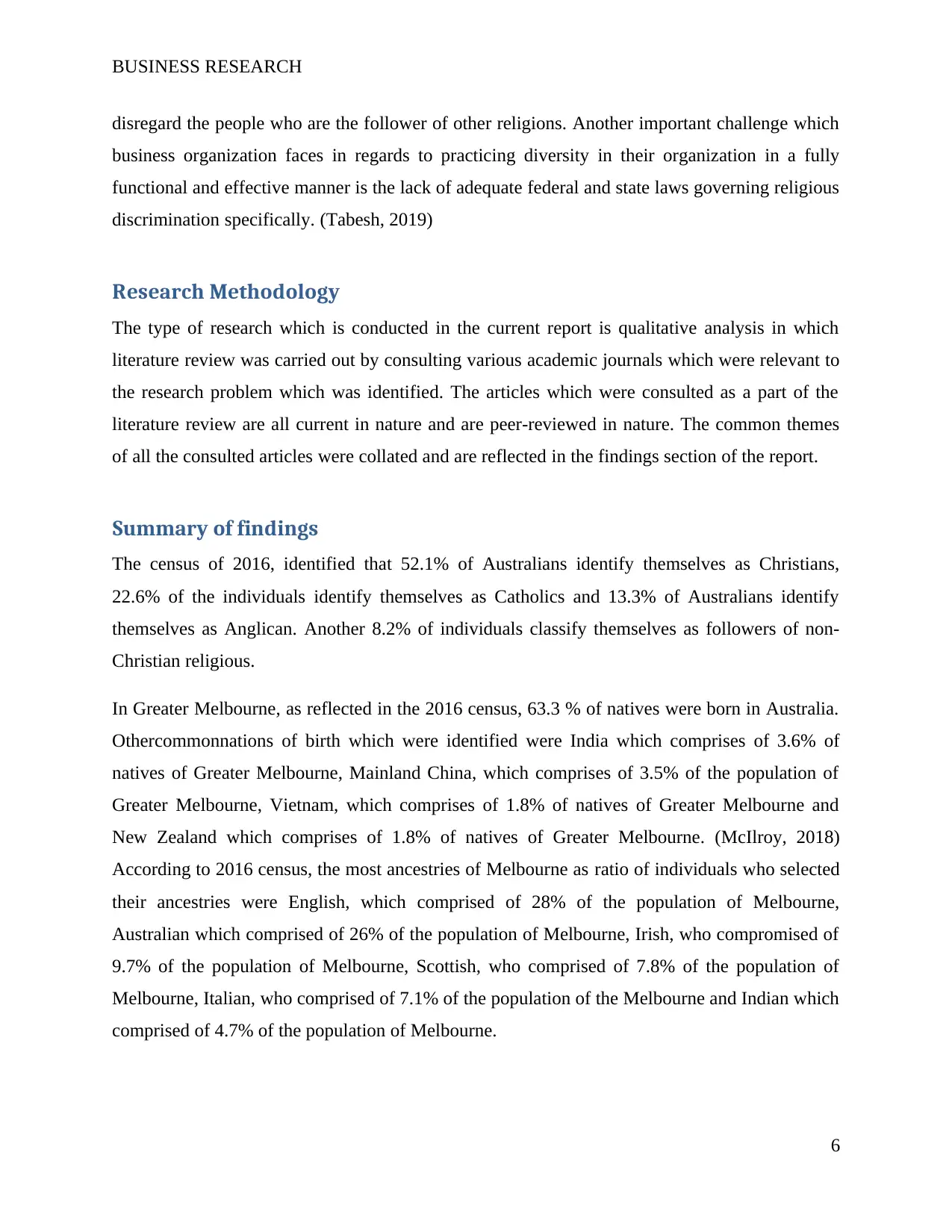
BUSINESS RESEARCH
disregard the people who are the follower of other religions. Another important challenge which
business organization faces in regards to practicing diversity in their organization in a fully
functional and effective manner is the lack of adequate federal and state laws governing religious
discrimination specifically. (Tabesh, 2019)
Research Methodology
The type of research which is conducted in the current report is qualitative analysis in which
literature review was carried out by consulting various academic journals which were relevant to
the research problem which was identified. The articles which were consulted as a part of the
literature review are all current in nature and are peer-reviewed in nature. The common themes
of all the consulted articles were collated and are reflected in the findings section of the report.
Summary of findings
The census of 2016, identified that 52.1% of Australians identify themselves as Christians,
22.6% of the individuals identify themselves as Catholics and 13.3% of Australians identify
themselves as Anglican. Another 8.2% of individuals classify themselves as followers of non-
Christian religious.
In Greater Melbourne, as reflected in the 2016 census, 63.3 % of natives were born in Australia.
Othercommonnations of birth which were identified were India which comprises of 3.6% of
natives of Greater Melbourne, Mainland China, which comprises of 3.5% of the population of
Greater Melbourne, Vietnam, which comprises of 1.8% of natives of Greater Melbourne and
New Zealand which comprises of 1.8% of natives of Greater Melbourne. (McIlroy, 2018)
According to 2016 census, the most ancestries of Melbourne as ratio of individuals who selected
their ancestries were English, which comprised of 28% of the population of Melbourne,
Australian which comprised of 26% of the population of Melbourne, Irish, who compromised of
9.7% of the population of Melbourne, Scottish, who comprised of 7.8% of the population of
Melbourne, Italian, who comprised of 7.1% of the population of the Melbourne and Indian which
comprised of 4.7% of the population of Melbourne.
6
disregard the people who are the follower of other religions. Another important challenge which
business organization faces in regards to practicing diversity in their organization in a fully
functional and effective manner is the lack of adequate federal and state laws governing religious
discrimination specifically. (Tabesh, 2019)
Research Methodology
The type of research which is conducted in the current report is qualitative analysis in which
literature review was carried out by consulting various academic journals which were relevant to
the research problem which was identified. The articles which were consulted as a part of the
literature review are all current in nature and are peer-reviewed in nature. The common themes
of all the consulted articles were collated and are reflected in the findings section of the report.
Summary of findings
The census of 2016, identified that 52.1% of Australians identify themselves as Christians,
22.6% of the individuals identify themselves as Catholics and 13.3% of Australians identify
themselves as Anglican. Another 8.2% of individuals classify themselves as followers of non-
Christian religious.
In Greater Melbourne, as reflected in the 2016 census, 63.3 % of natives were born in Australia.
Othercommonnations of birth which were identified were India which comprises of 3.6% of
natives of Greater Melbourne, Mainland China, which comprises of 3.5% of the population of
Greater Melbourne, Vietnam, which comprises of 1.8% of natives of Greater Melbourne and
New Zealand which comprises of 1.8% of natives of Greater Melbourne. (McIlroy, 2018)
According to 2016 census, the most ancestries of Melbourne as ratio of individuals who selected
their ancestries were English, which comprised of 28% of the population of Melbourne,
Australian which comprised of 26% of the population of Melbourne, Irish, who compromised of
9.7% of the population of Melbourne, Scottish, who comprised of 7.8% of the population of
Melbourne, Italian, who comprised of 7.1% of the population of the Melbourne and Indian which
comprised of 4.7% of the population of Melbourne.
6
⊘ This is a preview!⊘
Do you want full access?
Subscribe today to unlock all pages.

Trusted by 1+ million students worldwide
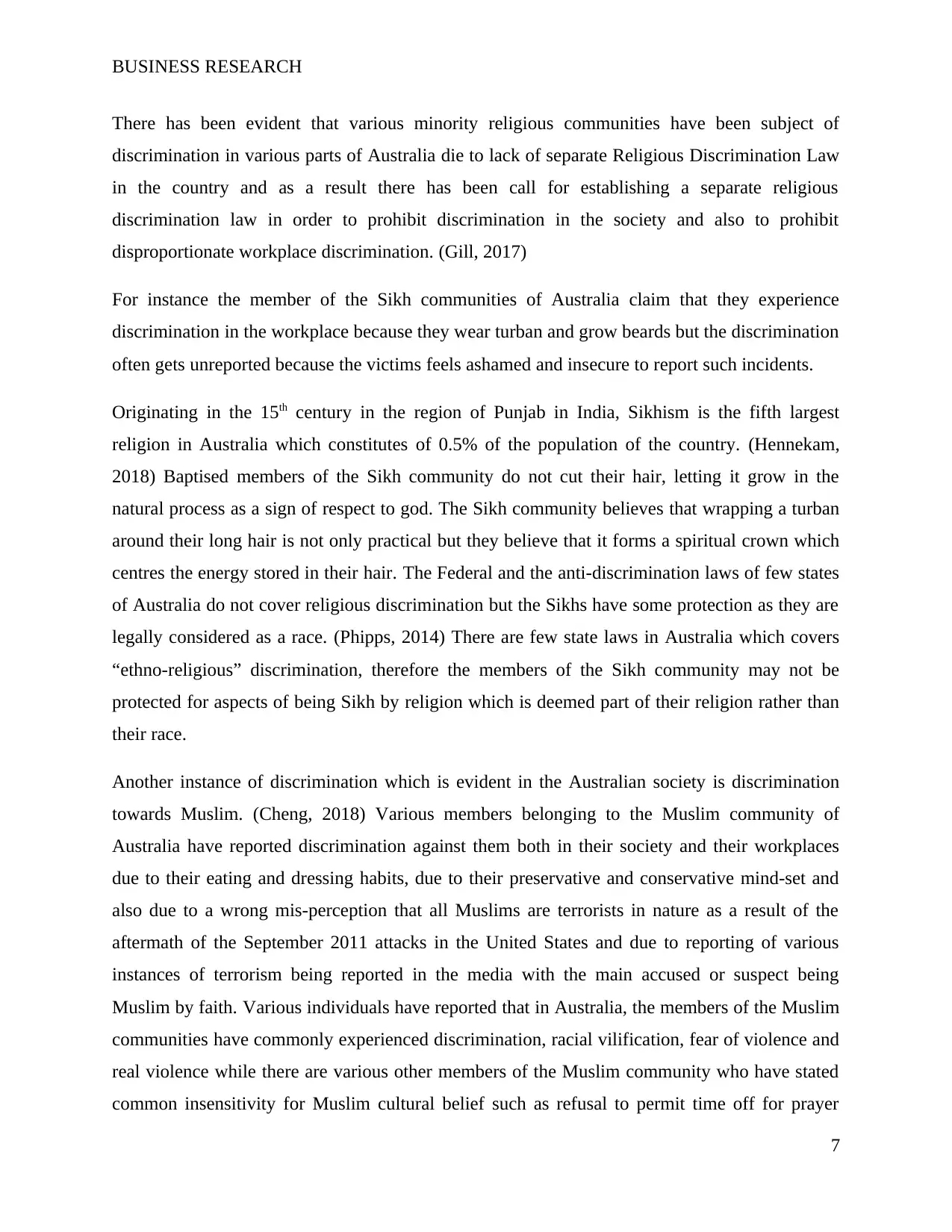
BUSINESS RESEARCH
There has been evident that various minority religious communities have been subject of
discrimination in various parts of Australia die to lack of separate Religious Discrimination Law
in the country and as a result there has been call for establishing a separate religious
discrimination law in order to prohibit discrimination in the society and also to prohibit
disproportionate workplace discrimination. (Gill, 2017)
For instance the member of the Sikh communities of Australia claim that they experience
discrimination in the workplace because they wear turban and grow beards but the discrimination
often gets unreported because the victims feels ashamed and insecure to report such incidents.
Originating in the 15th century in the region of Punjab in India, Sikhism is the fifth largest
religion in Australia which constitutes of 0.5% of the population of the country. (Hennekam,
2018) Baptised members of the Sikh community do not cut their hair, letting it grow in the
natural process as a sign of respect to god. The Sikh community believes that wrapping a turban
around their long hair is not only practical but they believe that it forms a spiritual crown which
centres the energy stored in their hair. The Federal and the anti-discrimination laws of few states
of Australia do not cover religious discrimination but the Sikhs have some protection as they are
legally considered as a race. (Phipps, 2014) There are few state laws in Australia which covers
“ethno-religious” discrimination, therefore the members of the Sikh community may not be
protected for aspects of being Sikh by religion which is deemed part of their religion rather than
their race.
Another instance of discrimination which is evident in the Australian society is discrimination
towards Muslim. (Cheng, 2018) Various members belonging to the Muslim community of
Australia have reported discrimination against them both in their society and their workplaces
due to their eating and dressing habits, due to their preservative and conservative mind-set and
also due to a wrong mis-perception that all Muslims are terrorists in nature as a result of the
aftermath of the September 2011 attacks in the United States and due to reporting of various
instances of terrorism being reported in the media with the main accused or suspect being
Muslim by faith. Various individuals have reported that in Australia, the members of the Muslim
communities have commonly experienced discrimination, racial vilification, fear of violence and
real violence while there are various other members of the Muslim community who have stated
common insensitivity for Muslim cultural belief such as refusal to permit time off for prayer
7
There has been evident that various minority religious communities have been subject of
discrimination in various parts of Australia die to lack of separate Religious Discrimination Law
in the country and as a result there has been call for establishing a separate religious
discrimination law in order to prohibit discrimination in the society and also to prohibit
disproportionate workplace discrimination. (Gill, 2017)
For instance the member of the Sikh communities of Australia claim that they experience
discrimination in the workplace because they wear turban and grow beards but the discrimination
often gets unreported because the victims feels ashamed and insecure to report such incidents.
Originating in the 15th century in the region of Punjab in India, Sikhism is the fifth largest
religion in Australia which constitutes of 0.5% of the population of the country. (Hennekam,
2018) Baptised members of the Sikh community do not cut their hair, letting it grow in the
natural process as a sign of respect to god. The Sikh community believes that wrapping a turban
around their long hair is not only practical but they believe that it forms a spiritual crown which
centres the energy stored in their hair. The Federal and the anti-discrimination laws of few states
of Australia do not cover religious discrimination but the Sikhs have some protection as they are
legally considered as a race. (Phipps, 2014) There are few state laws in Australia which covers
“ethno-religious” discrimination, therefore the members of the Sikh community may not be
protected for aspects of being Sikh by religion which is deemed part of their religion rather than
their race.
Another instance of discrimination which is evident in the Australian society is discrimination
towards Muslim. (Cheng, 2018) Various members belonging to the Muslim community of
Australia have reported discrimination against them both in their society and their workplaces
due to their eating and dressing habits, due to their preservative and conservative mind-set and
also due to a wrong mis-perception that all Muslims are terrorists in nature as a result of the
aftermath of the September 2011 attacks in the United States and due to reporting of various
instances of terrorism being reported in the media with the main accused or suspect being
Muslim by faith. Various individuals have reported that in Australia, the members of the Muslim
communities have commonly experienced discrimination, racial vilification, fear of violence and
real violence while there are various other members of the Muslim community who have stated
common insensitivity for Muslim cultural belief such as refusal to permit time off for prayer
7
Paraphrase This Document
Need a fresh take? Get an instant paraphrase of this document with our AI Paraphraser
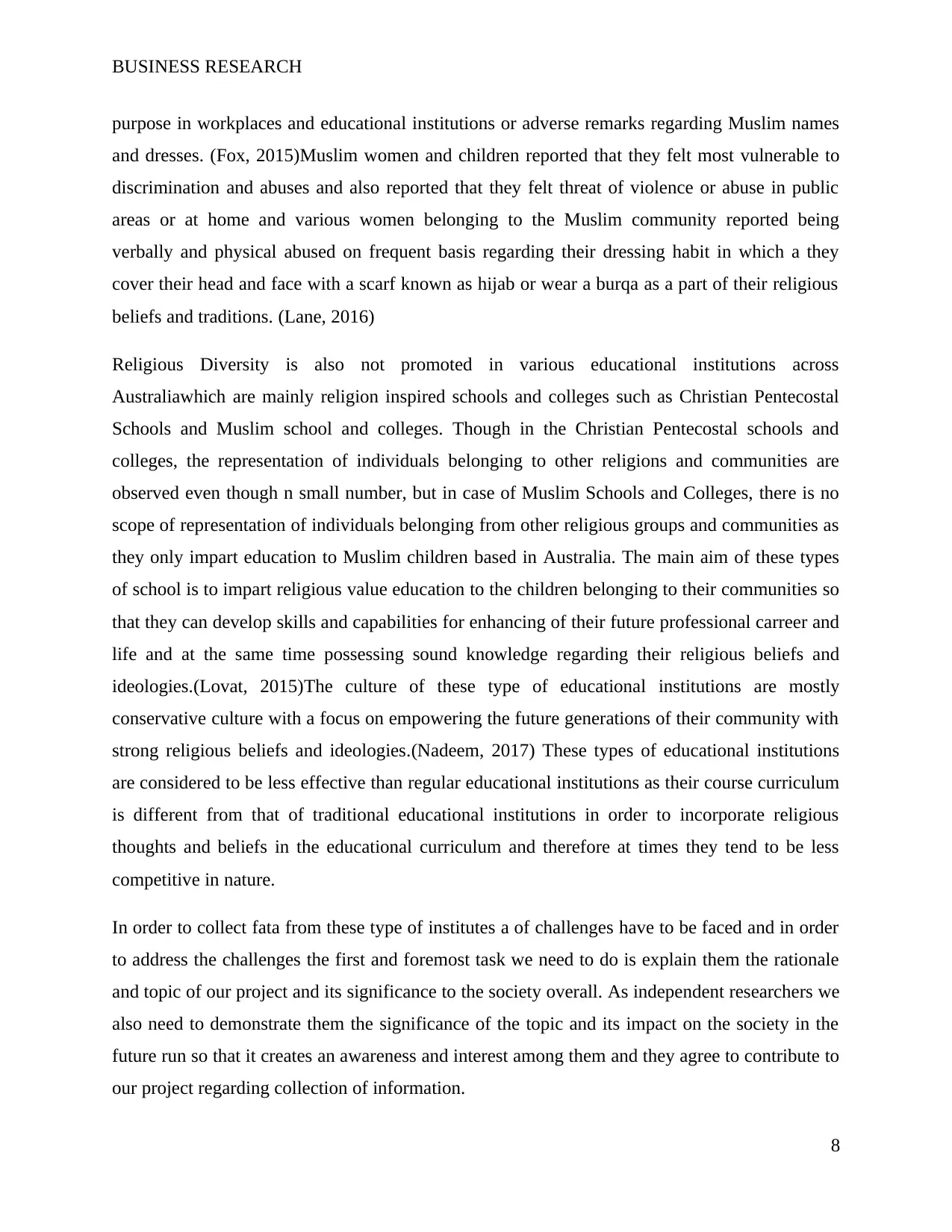
BUSINESS RESEARCH
purpose in workplaces and educational institutions or adverse remarks regarding Muslim names
and dresses. (Fox, 2015)Muslim women and children reported that they felt most vulnerable to
discrimination and abuses and also reported that they felt threat of violence or abuse in public
areas or at home and various women belonging to the Muslim community reported being
verbally and physical abused on frequent basis regarding their dressing habit in which a they
cover their head and face with a scarf known as hijab or wear a burqa as a part of their religious
beliefs and traditions. (Lane, 2016)
Religious Diversity is also not promoted in various educational institutions across
Australiawhich are mainly religion inspired schools and colleges such as Christian Pentecostal
Schools and Muslim school and colleges. Though in the Christian Pentecostal schools and
colleges, the representation of individuals belonging to other religions and communities are
observed even though n small number, but in case of Muslim Schools and Colleges, there is no
scope of representation of individuals belonging from other religious groups and communities as
they only impart education to Muslim children based in Australia. The main aim of these types
of school is to impart religious value education to the children belonging to their communities so
that they can develop skills and capabilities for enhancing of their future professional carreer and
life and at the same time possessing sound knowledge regarding their religious beliefs and
ideologies.(Lovat, 2015)The culture of these type of educational institutions are mostly
conservative culture with a focus on empowering the future generations of their community with
strong religious beliefs and ideologies.(Nadeem, 2017) These types of educational institutions
are considered to be less effective than regular educational institutions as their course curriculum
is different from that of traditional educational institutions in order to incorporate religious
thoughts and beliefs in the educational curriculum and therefore at times they tend to be less
competitive in nature.
In order to collect fata from these type of institutes a of challenges have to be faced and in order
to address the challenges the first and foremost task we need to do is explain them the rationale
and topic of our project and its significance to the society overall. As independent researchers we
also need to demonstrate them the significance of the topic and its impact on the society in the
future run so that it creates an awareness and interest among them and they agree to contribute to
our project regarding collection of information.
8
purpose in workplaces and educational institutions or adverse remarks regarding Muslim names
and dresses. (Fox, 2015)Muslim women and children reported that they felt most vulnerable to
discrimination and abuses and also reported that they felt threat of violence or abuse in public
areas or at home and various women belonging to the Muslim community reported being
verbally and physical abused on frequent basis regarding their dressing habit in which a they
cover their head and face with a scarf known as hijab or wear a burqa as a part of their religious
beliefs and traditions. (Lane, 2016)
Religious Diversity is also not promoted in various educational institutions across
Australiawhich are mainly religion inspired schools and colleges such as Christian Pentecostal
Schools and Muslim school and colleges. Though in the Christian Pentecostal schools and
colleges, the representation of individuals belonging to other religions and communities are
observed even though n small number, but in case of Muslim Schools and Colleges, there is no
scope of representation of individuals belonging from other religious groups and communities as
they only impart education to Muslim children based in Australia. The main aim of these types
of school is to impart religious value education to the children belonging to their communities so
that they can develop skills and capabilities for enhancing of their future professional carreer and
life and at the same time possessing sound knowledge regarding their religious beliefs and
ideologies.(Lovat, 2015)The culture of these type of educational institutions are mostly
conservative culture with a focus on empowering the future generations of their community with
strong religious beliefs and ideologies.(Nadeem, 2017) These types of educational institutions
are considered to be less effective than regular educational institutions as their course curriculum
is different from that of traditional educational institutions in order to incorporate religious
thoughts and beliefs in the educational curriculum and therefore at times they tend to be less
competitive in nature.
In order to collect fata from these type of institutes a of challenges have to be faced and in order
to address the challenges the first and foremost task we need to do is explain them the rationale
and topic of our project and its significance to the society overall. As independent researchers we
also need to demonstrate them the significance of the topic and its impact on the society in the
future run so that it creates an awareness and interest among them and they agree to contribute to
our project regarding collection of information.
8
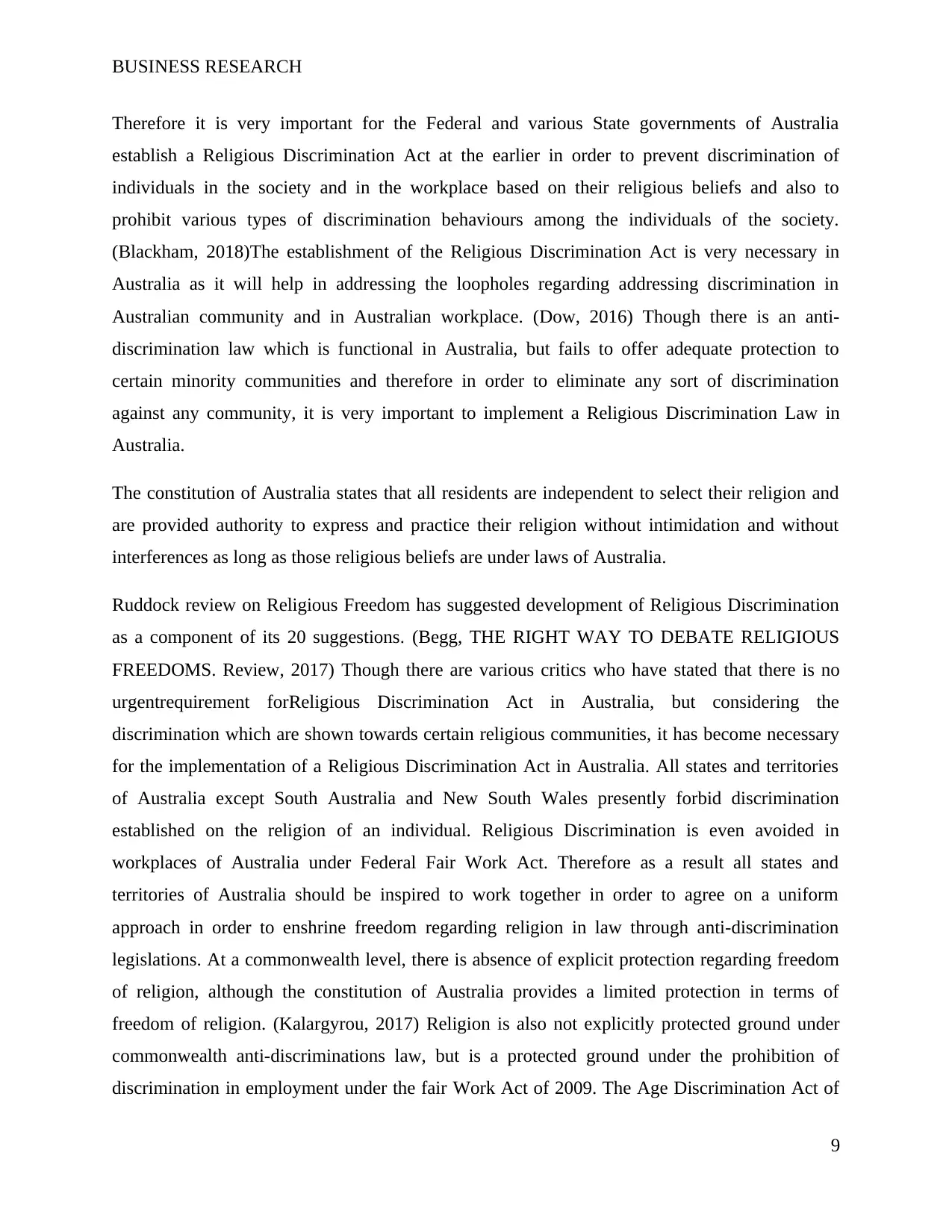
BUSINESS RESEARCH
Therefore it is very important for the Federal and various State governments of Australia
establish a Religious Discrimination Act at the earlier in order to prevent discrimination of
individuals in the society and in the workplace based on their religious beliefs and also to
prohibit various types of discrimination behaviours among the individuals of the society.
(Blackham, 2018)The establishment of the Religious Discrimination Act is very necessary in
Australia as it will help in addressing the loopholes regarding addressing discrimination in
Australian community and in Australian workplace. (Dow, 2016) Though there is an anti-
discrimination law which is functional in Australia, but fails to offer adequate protection to
certain minority communities and therefore in order to eliminate any sort of discrimination
against any community, it is very important to implement a Religious Discrimination Law in
Australia.
The constitution of Australia states that all residents are independent to select their religion and
are provided authority to express and practice their religion without intimidation and without
interferences as long as those religious beliefs are under laws of Australia.
Ruddock review on Religious Freedom has suggested development of Religious Discrimination
as a component of its 20 suggestions. (Begg, THE RIGHT WAY TO DEBATE RELIGIOUS
FREEDOMS. Review, 2017) Though there are various critics who have stated that there is no
urgentrequirement forReligious Discrimination Act in Australia, but considering the
discrimination which are shown towards certain religious communities, it has become necessary
for the implementation of a Religious Discrimination Act in Australia. All states and territories
of Australia except South Australia and New South Wales presently forbid discrimination
established on the religion of an individual. Religious Discrimination is even avoided in
workplaces of Australia under Federal Fair Work Act. Therefore as a result all states and
territories of Australia should be inspired to work together in order to agree on a uniform
approach in order to enshrine freedom regarding religion in law through anti-discrimination
legislations. At a commonwealth level, there is absence of explicit protection regarding freedom
of religion, although the constitution of Australia provides a limited protection in terms of
freedom of religion. (Kalargyrou, 2017) Religion is also not explicitly protected ground under
commonwealth anti-discriminations law, but is a protected ground under the prohibition of
discrimination in employment under the fair Work Act of 2009. The Age Discrimination Act of
9
Therefore it is very important for the Federal and various State governments of Australia
establish a Religious Discrimination Act at the earlier in order to prevent discrimination of
individuals in the society and in the workplace based on their religious beliefs and also to
prohibit various types of discrimination behaviours among the individuals of the society.
(Blackham, 2018)The establishment of the Religious Discrimination Act is very necessary in
Australia as it will help in addressing the loopholes regarding addressing discrimination in
Australian community and in Australian workplace. (Dow, 2016) Though there is an anti-
discrimination law which is functional in Australia, but fails to offer adequate protection to
certain minority communities and therefore in order to eliminate any sort of discrimination
against any community, it is very important to implement a Religious Discrimination Law in
Australia.
The constitution of Australia states that all residents are independent to select their religion and
are provided authority to express and practice their religion without intimidation and without
interferences as long as those religious beliefs are under laws of Australia.
Ruddock review on Religious Freedom has suggested development of Religious Discrimination
as a component of its 20 suggestions. (Begg, THE RIGHT WAY TO DEBATE RELIGIOUS
FREEDOMS. Review, 2017) Though there are various critics who have stated that there is no
urgentrequirement forReligious Discrimination Act in Australia, but considering the
discrimination which are shown towards certain religious communities, it has become necessary
for the implementation of a Religious Discrimination Act in Australia. All states and territories
of Australia except South Australia and New South Wales presently forbid discrimination
established on the religion of an individual. Religious Discrimination is even avoided in
workplaces of Australia under Federal Fair Work Act. Therefore as a result all states and
territories of Australia should be inspired to work together in order to agree on a uniform
approach in order to enshrine freedom regarding religion in law through anti-discrimination
legislations. At a commonwealth level, there is absence of explicit protection regarding freedom
of religion, although the constitution of Australia provides a limited protection in terms of
freedom of religion. (Kalargyrou, 2017) Religion is also not explicitly protected ground under
commonwealth anti-discriminations law, but is a protected ground under the prohibition of
discrimination in employment under the fair Work Act of 2009. The Age Discrimination Act of
9
⊘ This is a preview!⊘
Do you want full access?
Subscribe today to unlock all pages.

Trusted by 1+ million students worldwide

BUSINESS RESEARCH
2004 and the Sex Discrimination Act of 1984 also contain a general religious exemption. As a
result of the ad-hoc nature regarding the ways the laws have been legislated, it can be argued that
the country requires a codified response to this development and therefore Australia needs a
Religious Discrimination Act at the earliest in order to prevent any forms of religious
discrimination in the country.
A Religious Discrimination Act has become vital in order to implement other important
protections for the religious diverse population of Australia. (Begg, DEFENDING RELIGIOUS
LIBERTY. Review, 2018)Alongside Christian who constitute about the half the population of
the country, Australia is home to various other religious minorities in the form of Muslims who
make up about 2.6% of the population of the country, Hindus who make up of 1.9% of the
population of the country and Sikhs who make up of 0.5% of the population of the country. A
religious Discrimination Act will also help in protecting a growing number of Australians who
have identified themselves of having no religion and it constitutes of about 30% of the
population of the country.
Religious Discrimination is not an emerging issue in Australia as twenty years ago the Human
Rights and equal Opportunity Commission stated that in spite of the legal protections which
apply in different jurisdictions in Australia, many Australians experience discrimination on the
basis of religious belief and non-belief, which includes members of both mainstream religion and
non-mainstream religion and those of no religious persuasions.
The submissions which were received by the commission detailed the areas in which the
individuals residing in the country experienced religious discrimination. (Ghazzawi, 2016) For
examples, the individuals belonging to the Pagan Community experienced difficulties in hiring
various facilities in order to conduct their various religious events, while the individuals who
belonged to the Muslim, Buddhist and Sikh communities reported of experiencing problems with
planning authorities. Some individuals also reported that they prefer to keep their religion as a
secret at their workplaces for the fear of being suspended from the workplace or denied
promotion at the workplace. Therefore the commission recommended the introduction of a
Federal Religious Act, which included provisions preventing discrimination based on the religion
of an individual.
10
2004 and the Sex Discrimination Act of 1984 also contain a general religious exemption. As a
result of the ad-hoc nature regarding the ways the laws have been legislated, it can be argued that
the country requires a codified response to this development and therefore Australia needs a
Religious Discrimination Act at the earliest in order to prevent any forms of religious
discrimination in the country.
A Religious Discrimination Act has become vital in order to implement other important
protections for the religious diverse population of Australia. (Begg, DEFENDING RELIGIOUS
LIBERTY. Review, 2018)Alongside Christian who constitute about the half the population of
the country, Australia is home to various other religious minorities in the form of Muslims who
make up about 2.6% of the population of the country, Hindus who make up of 1.9% of the
population of the country and Sikhs who make up of 0.5% of the population of the country. A
religious Discrimination Act will also help in protecting a growing number of Australians who
have identified themselves of having no religion and it constitutes of about 30% of the
population of the country.
Religious Discrimination is not an emerging issue in Australia as twenty years ago the Human
Rights and equal Opportunity Commission stated that in spite of the legal protections which
apply in different jurisdictions in Australia, many Australians experience discrimination on the
basis of religious belief and non-belief, which includes members of both mainstream religion and
non-mainstream religion and those of no religious persuasions.
The submissions which were received by the commission detailed the areas in which the
individuals residing in the country experienced religious discrimination. (Ghazzawi, 2016) For
examples, the individuals belonging to the Pagan Community experienced difficulties in hiring
various facilities in order to conduct their various religious events, while the individuals who
belonged to the Muslim, Buddhist and Sikh communities reported of experiencing problems with
planning authorities. Some individuals also reported that they prefer to keep their religion as a
secret at their workplaces for the fear of being suspended from the workplace or denied
promotion at the workplace. Therefore the commission recommended the introduction of a
Federal Religious Act, which included provisions preventing discrimination based on the religion
of an individual.
10
Paraphrase This Document
Need a fresh take? Get an instant paraphrase of this document with our AI Paraphraser
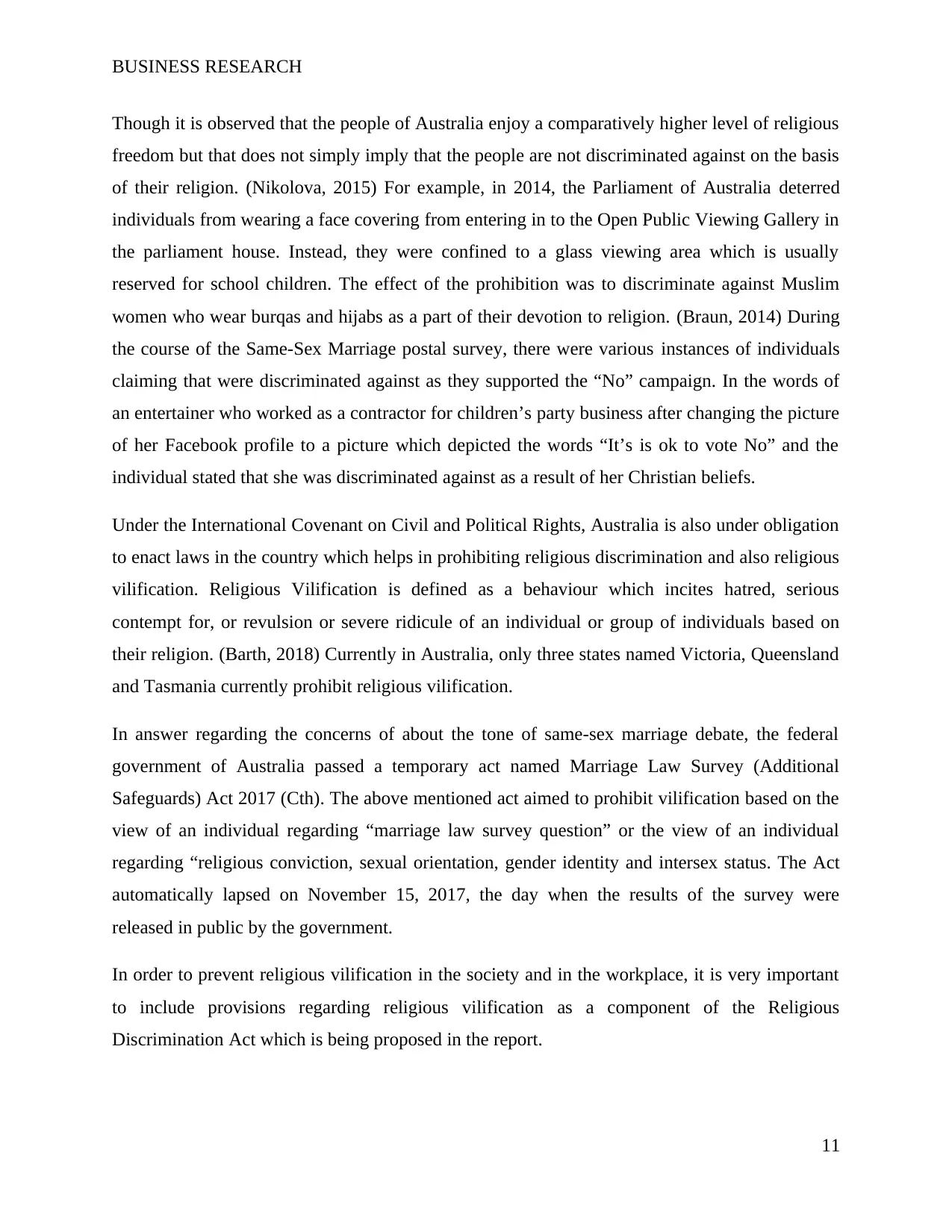
BUSINESS RESEARCH
Though it is observed that the people of Australia enjoy a comparatively higher level of religious
freedom but that does not simply imply that the people are not discriminated against on the basis
of their religion. (Nikolova, 2015) For example, in 2014, the Parliament of Australia deterred
individuals from wearing a face covering from entering in to the Open Public Viewing Gallery in
the parliament house. Instead, they were confined to a glass viewing area which is usually
reserved for school children. The effect of the prohibition was to discriminate against Muslim
women who wear burqas and hijabs as a part of their devotion to religion. (Braun, 2014) During
the course of the Same-Sex Marriage postal survey, there were various instances of individuals
claiming that were discriminated against as they supported the “No” campaign. In the words of
an entertainer who worked as a contractor for children’s party business after changing the picture
of her Facebook profile to a picture which depicted the words “It’s is ok to vote No” and the
individual stated that she was discriminated against as a result of her Christian beliefs.
Under the International Covenant on Civil and Political Rights, Australia is also under obligation
to enact laws in the country which helps in prohibiting religious discrimination and also religious
vilification. Religious Vilification is defined as a behaviour which incites hatred, serious
contempt for, or revulsion or severe ridicule of an individual or group of individuals based on
their religion. (Barth, 2018) Currently in Australia, only three states named Victoria, Queensland
and Tasmania currently prohibit religious vilification.
In answer regarding the concerns of about the tone of same-sex marriage debate, the federal
government of Australia passed a temporary act named Marriage Law Survey (Additional
Safeguards) Act 2017 (Cth). The above mentioned act aimed to prohibit vilification based on the
view of an individual regarding “marriage law survey question” or the view of an individual
regarding “religious conviction, sexual orientation, gender identity and intersex status. The Act
automatically lapsed on November 15, 2017, the day when the results of the survey were
released in public by the government.
In order to prevent religious vilification in the society and in the workplace, it is very important
to include provisions regarding religious vilification as a component of the Religious
Discrimination Act which is being proposed in the report.
11
Though it is observed that the people of Australia enjoy a comparatively higher level of religious
freedom but that does not simply imply that the people are not discriminated against on the basis
of their religion. (Nikolova, 2015) For example, in 2014, the Parliament of Australia deterred
individuals from wearing a face covering from entering in to the Open Public Viewing Gallery in
the parliament house. Instead, they were confined to a glass viewing area which is usually
reserved for school children. The effect of the prohibition was to discriminate against Muslim
women who wear burqas and hijabs as a part of their devotion to religion. (Braun, 2014) During
the course of the Same-Sex Marriage postal survey, there were various instances of individuals
claiming that were discriminated against as they supported the “No” campaign. In the words of
an entertainer who worked as a contractor for children’s party business after changing the picture
of her Facebook profile to a picture which depicted the words “It’s is ok to vote No” and the
individual stated that she was discriminated against as a result of her Christian beliefs.
Under the International Covenant on Civil and Political Rights, Australia is also under obligation
to enact laws in the country which helps in prohibiting religious discrimination and also religious
vilification. Religious Vilification is defined as a behaviour which incites hatred, serious
contempt for, or revulsion or severe ridicule of an individual or group of individuals based on
their religion. (Barth, 2018) Currently in Australia, only three states named Victoria, Queensland
and Tasmania currently prohibit religious vilification.
In answer regarding the concerns of about the tone of same-sex marriage debate, the federal
government of Australia passed a temporary act named Marriage Law Survey (Additional
Safeguards) Act 2017 (Cth). The above mentioned act aimed to prohibit vilification based on the
view of an individual regarding “marriage law survey question” or the view of an individual
regarding “religious conviction, sexual orientation, gender identity and intersex status. The Act
automatically lapsed on November 15, 2017, the day when the results of the survey were
released in public by the government.
In order to prevent religious vilification in the society and in the workplace, it is very important
to include provisions regarding religious vilification as a component of the Religious
Discrimination Act which is being proposed in the report.
11
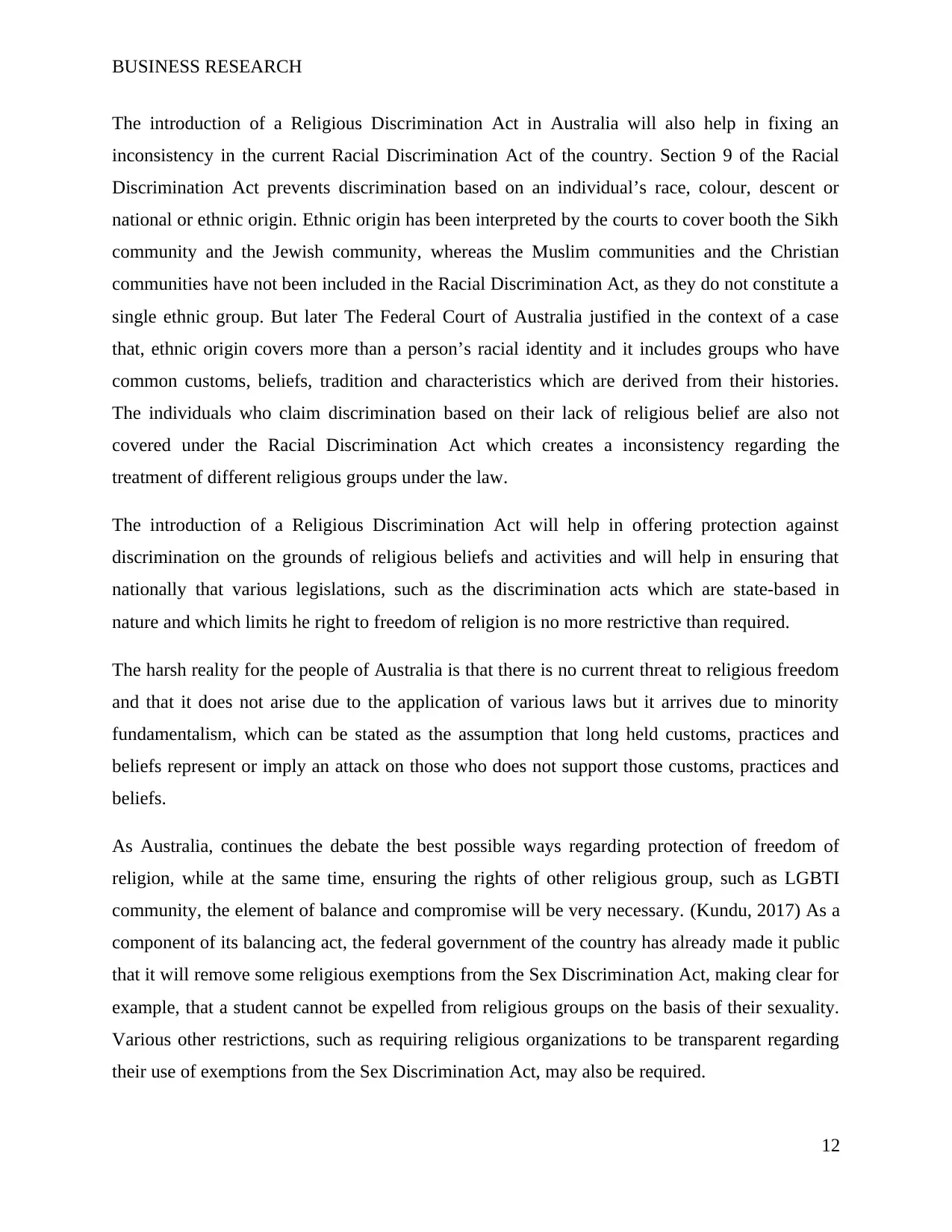
BUSINESS RESEARCH
The introduction of a Religious Discrimination Act in Australia will also help in fixing an
inconsistency in the current Racial Discrimination Act of the country. Section 9 of the Racial
Discrimination Act prevents discrimination based on an individual’s race, colour, descent or
national or ethnic origin. Ethnic origin has been interpreted by the courts to cover booth the Sikh
community and the Jewish community, whereas the Muslim communities and the Christian
communities have not been included in the Racial Discrimination Act, as they do not constitute a
single ethnic group. But later The Federal Court of Australia justified in the context of a case
that, ethnic origin covers more than a person’s racial identity and it includes groups who have
common customs, beliefs, tradition and characteristics which are derived from their histories.
The individuals who claim discrimination based on their lack of religious belief are also not
covered under the Racial Discrimination Act which creates a inconsistency regarding the
treatment of different religious groups under the law.
The introduction of a Religious Discrimination Act will help in offering protection against
discrimination on the grounds of religious beliefs and activities and will help in ensuring that
nationally that various legislations, such as the discrimination acts which are state-based in
nature and which limits he right to freedom of religion is no more restrictive than required.
The harsh reality for the people of Australia is that there is no current threat to religious freedom
and that it does not arise due to the application of various laws but it arrives due to minority
fundamentalism, which can be stated as the assumption that long held customs, practices and
beliefs represent or imply an attack on those who does not support those customs, practices and
beliefs.
As Australia, continues the debate the best possible ways regarding protection of freedom of
religion, while at the same time, ensuring the rights of other religious group, such as LGBTI
community, the element of balance and compromise will be very necessary. (Kundu, 2017) As a
component of its balancing act, the federal government of the country has already made it public
that it will remove some religious exemptions from the Sex Discrimination Act, making clear for
example, that a student cannot be expelled from religious groups on the basis of their sexuality.
Various other restrictions, such as requiring religious organizations to be transparent regarding
their use of exemptions from the Sex Discrimination Act, may also be required.
12
The introduction of a Religious Discrimination Act in Australia will also help in fixing an
inconsistency in the current Racial Discrimination Act of the country. Section 9 of the Racial
Discrimination Act prevents discrimination based on an individual’s race, colour, descent or
national or ethnic origin. Ethnic origin has been interpreted by the courts to cover booth the Sikh
community and the Jewish community, whereas the Muslim communities and the Christian
communities have not been included in the Racial Discrimination Act, as they do not constitute a
single ethnic group. But later The Federal Court of Australia justified in the context of a case
that, ethnic origin covers more than a person’s racial identity and it includes groups who have
common customs, beliefs, tradition and characteristics which are derived from their histories.
The individuals who claim discrimination based on their lack of religious belief are also not
covered under the Racial Discrimination Act which creates a inconsistency regarding the
treatment of different religious groups under the law.
The introduction of a Religious Discrimination Act will help in offering protection against
discrimination on the grounds of religious beliefs and activities and will help in ensuring that
nationally that various legislations, such as the discrimination acts which are state-based in
nature and which limits he right to freedom of religion is no more restrictive than required.
The harsh reality for the people of Australia is that there is no current threat to religious freedom
and that it does not arise due to the application of various laws but it arrives due to minority
fundamentalism, which can be stated as the assumption that long held customs, practices and
beliefs represent or imply an attack on those who does not support those customs, practices and
beliefs.
As Australia, continues the debate the best possible ways regarding protection of freedom of
religion, while at the same time, ensuring the rights of other religious group, such as LGBTI
community, the element of balance and compromise will be very necessary. (Kundu, 2017) As a
component of its balancing act, the federal government of the country has already made it public
that it will remove some religious exemptions from the Sex Discrimination Act, making clear for
example, that a student cannot be expelled from religious groups on the basis of their sexuality.
Various other restrictions, such as requiring religious organizations to be transparent regarding
their use of exemptions from the Sex Discrimination Act, may also be required.
12
⊘ This is a preview!⊘
Do you want full access?
Subscribe today to unlock all pages.

Trusted by 1+ million students worldwide
1 out of 19
Related Documents
Your All-in-One AI-Powered Toolkit for Academic Success.
+13062052269
info@desklib.com
Available 24*7 on WhatsApp / Email
![[object Object]](/_next/static/media/star-bottom.7253800d.svg)
Unlock your academic potential
Copyright © 2020–2025 A2Z Services. All Rights Reserved. Developed and managed by ZUCOL.




